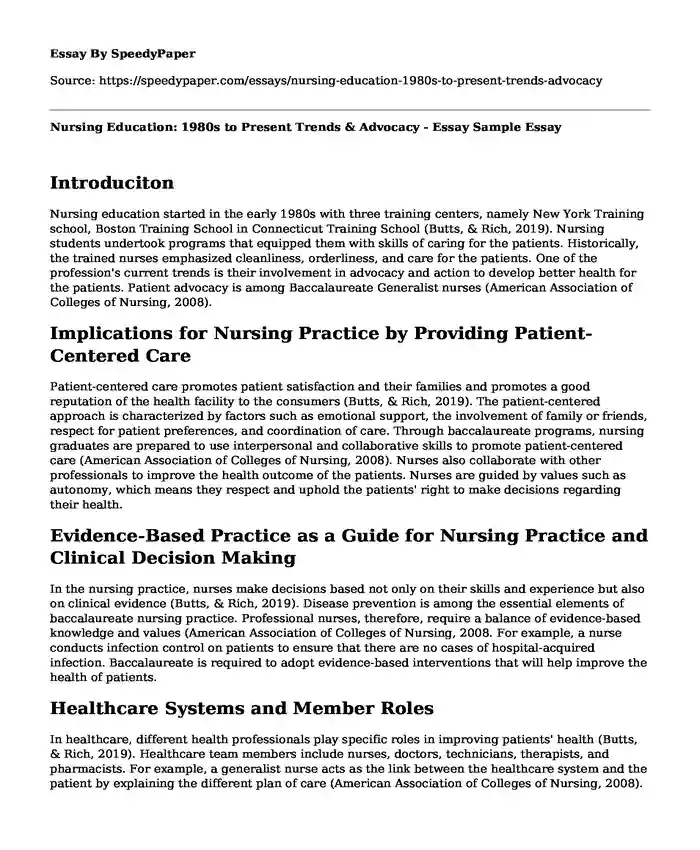Introduciton
Nursing education started in the early 1980s with three training centers, namely New York Training school, Boston Training School in Connecticut Training School (Butts, & Rich, 2019). Nursing students undertook programs that equipped them with skills of caring for the patients. Historically, the trained nurses emphasized cleanliness, orderliness, and care for the patients. One of the profession's current trends is their involvement in advocacy and action to develop better health for the patients. Patient advocacy is among Baccalaureate Generalist nurses (American Association of Colleges of Nursing, 2008).
Implications for Nursing Practice by Providing Patient-Centered Care
Patient-centered care promotes patient satisfaction and their families and promotes a good reputation of the health facility to the consumers (Butts, & Rich, 2019). The patient-centered approach is characterized by factors such as emotional support, the involvement of family or friends, respect for patient preferences, and coordination of care. Through baccalaureate programs, nursing graduates are prepared to use interpersonal and collaborative skills to promote patient-centered care (American Association of Colleges of Nursing, 2008). Nurses also collaborate with other professionals to improve the health outcome of the patients. Nurses are guided by values such as autonomy, which means they respect and uphold the patients' right to make decisions regarding their health.
Evidence-Based Practice as a Guide for Nursing Practice and Clinical Decision Making
In the nursing practice, nurses make decisions based not only on their skills and experience but also on clinical evidence (Butts, & Rich, 2019). Disease prevention is among the essential elements of baccalaureate nursing practice. Professional nurses, therefore, require a balance of evidence-based knowledge and values (American Association of Colleges of Nursing, 2008. For example, a nurse conducts infection control on patients to ensure that there are no cases of hospital-acquired infection. Baccalaureate is required to adopt evidence-based interventions that will help improve the health of patients.
Healthcare Systems and Member Roles
In healthcare, different health professionals play specific roles in improving patients' health (Butts, & Rich, 2019). Healthcare team members include nurses, doctors, technicians, therapists, and pharmacists. For example, a generalist nurse acts as the link between the healthcare system and the patient by explaining the different plan of care (American Association of Colleges of Nursing, 2008). Although each team member has specific roles, they all collaborate to achieve patient-centered care. When a patient visits a healthcare facility, for instance, he/she consults a doctor who sends him to a laboratory technician after conducting tests the technician sends him back to the doctor and then to the pharmacy. For quality treatment, therefore, each member has to effectively carry out the assigned role.
Improving Patient Care Outcomes through Safe Care Environment.
Information technology can be used to ensure a safe care environment that, in turn, improves patient care outcomes. Technologies such as information systems and CCTV can be used to check the flow of patients from one department to the other (Singh & Sittig, 2016). Information systems allow the sharing of information among departments; hence doctors can track the patient. The CCTV displays the position of the patients on the screen for easy location.
Quality Improvement Effects
Quality improvement increases the recovery speed of the patients because they get the treatment they require in a good time. The healthcare systems are streamlines, where patients take less time during consultations, and the general morale of healthcare workers is improved (American Association of Colleges of Nursing, 2008).
In conclusion, the nursing practice profession has improved over the years, where new ways of doing work have emerged to make the work of nurses easier. The nurses are now able to get the support they require to make quick decisions and respond faster to emergencies. Healthcare systems have evolved to meet patient needs and improved patient outcomes, including making hospitals a safe environment where patients access medical care.
References
American Association of Colleges of Nursing (AACN). (2008). The Essentials of Baccalaureate Education for Professional Nursing Practice. https://www.aacnnursing.org/Portals/42/Publications/BaccEssentials08.pdf
Butts, J. B., & Rich, K. L. (2019). Nursing ethics. Jones & Bartlett Learning. https://books.google.co.ke/books?hl=en&lr=&id=dx6DDwAAQBAJ&oi=fnd&pg=PP1&dq=nursing+&ots=RojWKaKO06&sig=JAKmsKG0o-FCAnG-m1rqY8uJ84M&redir_esc=y#v=onepage&q=nursing&f=false
Singh, H., & Sittig, D. F. (2016). Measuring and improving patient safety through health information technology: The Health IT Safety Framework. BMJ quality & safety, 25(4), 226-232.
Cite this page
Nursing Education: 1980s to Present Trends & Advocacy - Essay Sample. (2023, Nov 24). Retrieved from https://speedypaper.net/essays/nursing-education-1980s-to-present-trends-advocacy
Request Removal
If you are the original author of this essay and no longer wish to have it published on the SpeedyPaper website, please click below to request its removal:
- Finding Inspiration Is a Pressing Feature in Life, Free Essay
- Free Essay with a Reflective Letter on Teaching and Learning a Second Language
- Free Essay for You: Philosophy of Language, Frege and Russel
- Free Essay on the Role of the Family Nurse Practitioner
- Queer Immigrant Admission Essay, Free Example
- Free Essay - the Rio Grande River
- Reflection Essay on Exceptional Education
Popular categories





